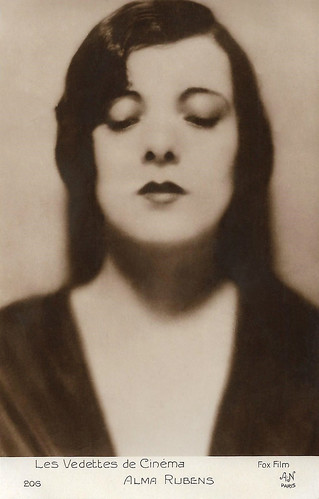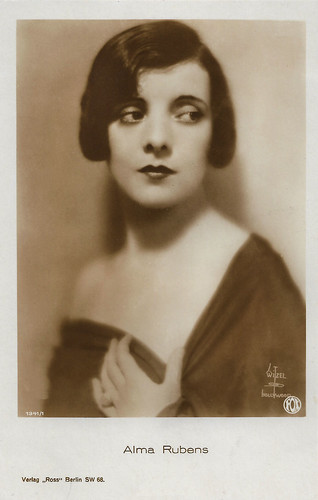
Austrian postcard by Iris Verlag, no. 871. Photo: Witzel, Los Angeles / Fox.

British Real Photograph postcard.
The newest starlet of William Randolph Hearst's Cosmopolitan Productions
Alma Genevieve Reubens was born in 1897 in San Francisco, California. Her parents were John B. and Theresa (née Hayes) Reubens. She and her elder sister, Hazel (born 1893) attended Sacred Heart Convent in San Francisco. Her first stage opportunity came when a chorus girl in a musical comedy theatre troupe became ill. Rubens was chosen to take her place and joined the troupe as a regular performer. There she met actor Franklyn Farnum, nearly 20 years her senior, and the two married secretly.
Farnum later convinced Rubens to leave the troupe and try film acting. In 1916, Rubens signed with Triangle Film Corporation. Her first film for the company was the comedy-drama Reggie Mixes In (Christy Cabanne, 1916), starring Douglas Fairbanks and Bessie Love. Later the same year, Rubens was re-teamed with Fairbanks for the comedy The Mystery of the Leaping Fish (John Emerson, 1916), The Half-Breed (Allan Dwan, 1916) and The Americano (John Emerson, 1916). The next year, Rubens co-starred in two Westerns, Truthful Tolliver (William S. Hart, 1917) with William S. Hart and The Firefly of Tough Luck (E. Mason Hopper, 1917) with Charles Gunn.
In 1918, she announced that she was changing the spelling of her last name of Ruebens to "Rubens" because it caused too much confusion in the movie industry and publications. In 1920, Rubens signed with William Randolph Hearst's Cosmopolitan Productions. The studio promoted Rubens as its newest starlet, falsely claiming she was a descendant of Flemish painter Peter Paul Rubens. Her first film for the studio was Humoresque (Frank Borzage, 1920), which became the studio's only hit that year. Later that year, she starred in dramas The World and His Wife (Robert G. Vignola, 1920) opposite Montague Love, and Thoughtless Women (Daniel Carson Goodman, 1920), which further solidified her popularity.
By 1921, Alma Rubens had developed an addiction to heroin after she was prescribed morphine by a doctor for a physical ailment. Due to her drug use and difficult behaviour on set, William Randolph Hearst removed her from a film she was set to star in but kept her on the payroll for the next two years. There were rumours that Hearst continued to pay her a salary because the two were involved romantically. Hearst denied this rumour, claiming he continued to pay Rubens because he had invested a substantial amount of money promoting her as the studio's leading lady and that a good lead actress was difficult to find.
Rubens returned to the screen in 1922 with roles in the mystery Find the Woman (Tom Terriss, 1922) and The Valley of Silent Men (Frank Borzage, 1922) with Lew Cody. Her final film for Cosmopolitan Productions was the historical drama Under the Red Robe (Alan Crosland, 1923). Hearst released Rubens from her contract the same year. In 1924, she starred in The Price She Paid (Henry MacRae, 1924) for Columbia Pictures Corporation and had a supporting role in the Associated First National silent romantic drama Cytherea (George Fitzmaurice, 1924). From 1925 to 1926, she worked for Fox Film Corporation. While at Fox, she starred in the hit melodrama East Lynne (Emmett J. Flynn, 1925) opposite Edmund Lowe and Lou Tellegen. She also had roles in The Gilded Butterfly (John Griffith Wray, 1926) with Bert Lytell and Siberia (Victor Schertzinger, 1926), which re-teamed Rubens with Edmund Lowe and Lou Tellegen. Her final film for Fox was Heart of Salome (Victor Schertzinger, 1927), after which she decided to work freelance.

French postcard in the Les Vedettes de Cinéma Series, by A.N., Paris, no. 206. Photo: Fox Film.

German postcard by Ross Verlag, Berlin no. 1341/1, 1927-1928. Photo: Witzel / Fox.
A publicly known drug addiction
By late 1927, Alma Rubens' drug addiction severely impacted her career as she frequently was admitted to sanitariums for treatment for months at a time. One of her latter roles was as Julie in the part-sound film version of Show Boat (Harry A. Pollard, 1929), her next-to-last film role and one of her few sound films. However, the soundtrack for the portion in which she spoke is lost. In February 1929, Rubens' addiction became known publicly when she attempted to stab a physician who was taking her to a sanitarium for treatment. She was ordered to undergo treatment at the Spadra facility shortly after that. She later escaped despite being under the watch of four nurses and two male guards. She then was admitted to a sanatorium in Pasadena but left after 10 days.
Then, Rubens' husband Ricardo Cortez and her mother had Rubens committed to Patton State Hospital for treatment after she resumed her drug habit. Rubens was released from Patton State Hospital in late 1929. She made her first public appearance since her release on 30 January 1930, in a role in a play produced at the Writer's Club in Hollywood. Her performance was well received by the audience, and she received eight curtain calls. After the show, Rubens gave an interview to United Press stating that she was cured of her addiction. During the interview, she described her descent into drug abuse and her experiences at the sanatoriums. In early February 1930, Rubens travelled to New York where she announced she was now free of drug addiction and planning a comeback with a Vaudeville tour in the East. She made an appearance on stage with her husband but returned to California the same month.
On 5 January 1931, Alma Rubens was arrested by Federal officers in San Diego for cocaine possession and conspiracy to smuggle morphine from Mexico into the United States. Rubens claimed she was being framed, and physicians attested to her statements that she was not taking drugs. She later was released on $5,000 bail and appeared for a preliminary hearing the second week of January 1931.
Shortly after her release from jail on charges of cocaine possession, Rubens contracted a cold that quickly developed into lobar pneumonia and bronchitis. She fell into a coma at the Los Angeles home of her friend, Dr. Charles J. Pflueger. She died on 21 January 1931, at the age of 33 having never regained consciousness. After a funeral service, her body was shipped to Fresno where a second service was held at the Christian Science Church. She is interred in a mausoleum at Mountain View Cemetery in Fresno.
Alma Rubens married three times. Her first marriage was to actor Franklyn Farnum in 1918. Rubens and Farnum were married secretly and separated about two months later. According to Rubens' divorce petition, Farnum physically abused her and once dislocated her jaw. Their divorce was finalised in 1919. In 1923, she married Dr. Daniel Carson Goodman, an author and film producer. They separated in late 1924, and Rubens filed for divorce in 1925. Rubens's third and final marriage was to actor Ricardo Cortez, whom she married in 1926. While touring the Vaudeville circuit in mid-1930, the couple separated. At the time of her death, Rubens was suing Cortez for divorce. Cortez claimed he had not been notified of his wife's death, and later remarked that he had not seen her for several months and was unaware that she was seriously ill.

Swedish postcard by Förlag Nordisk Konst, Stockholm, no. 857. Photo: Triangle-Film.

British postcard in the Picturegoer Series, London, no. 204a.
Sources: Wikipedia and IMDb.
No comments:
Post a Comment